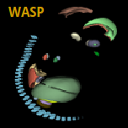Difference between revisions of "Documentation/Nightly/Extensions/Wasp"
| Line 32: | Line 32: | ||
*Annotation stage: Creating a new label map out of selected components from the watershed stage | *Annotation stage: Creating a new label map out of selected components from the watershed stage | ||
| − | !Watershed stage | + | !Watershed stage! |
It allows the user to perform a series of Watershed segmentations on a 3D image using the SimpleITK “Morphological Watershed” without seeds. | It allows the user to perform a series of Watershed segmentations on a 3D image using the SimpleITK “Morphological Watershed” without seeds. | ||
| Line 43: | Line 43: | ||
A user can then use a range for this parameter (e.g. 1 to 2 with steps of 0.1 resulting in 20 label map results) | A user can then use a range for this parameter (e.g. 1 to 2 with steps of 0.1 resulting in 20 label map results) | ||
| − | !Annotation stage | + | !Annotation stage! |
The user can then select individual segmentations out of any of the watershed produced label map using fiducials. | The user can then select individual segmentations out of any of the watershed produced label map using fiducials. | ||
Revision as of 18:41, 22 December 2014
Home < Documentation < Nightly < Extensions < Wasp
|
For the latest Slicer documentation, visit the read-the-docs. |
Introduction and Acknowledgements
|
Extension: Wasp Author: Thomas Lawson
|
|
|
Module Description
Watershed Annotation and Segmentation Plugin for 3D Slicer
The plugin consists of two main components
- Watershed stage: Perform a series of watershed filters on the original image
- Annotation stage: Creating a new label map out of selected components from the watershed stage
!Watershed stage!
It allows the user to perform a series of Watershed segmentations on a 3D image using the SimpleITK “Morphological Watershed” without seeds.
They can edit various parameters but importantly they can choose a range of values to use for the “watershed level”.
- When the watershed value is lower the image will be segmented into more components.
- When the watershed level is higher the image will be segmented into less components
A user can then use a range for this parameter (e.g. 1 to 2 with steps of 0.1 resulting in 20 label map results)
!Annotation stage!
The user can then select individual segmentations out of any of the watershed produced label map using fiducials.
This will create a new label map with only the components the user has chosen. The user can also choose the order of the labels as well.
A model of the label map is generated as well.
Use Cases
Tutorials
Panels and their use
Similar Modules
References
Information for Developers
| Section under construction. |
